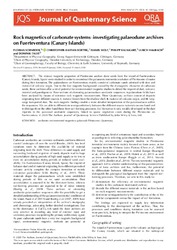Rock magnetics of carbonate systems–investigating palaeodune archives on Fuerteventura (Canary Islands)
Roettig, Christopher-Bastian
Wolf, Daniel
Baumgart, Philipp
Hambach, Ulrich
Faust, Dominik
DOI: https://doi.org/10.1002/jqs.3202
Persistent URL: http://resolver.sub.uni-goettingen.de/purl?gldocs-11858/8791
Persistent URL: http://resolver.sub.uni-goettingen.de/purl?gldocs-11858/8791
Schneider, Florian; Roettig, Christopher-Bastian; Wolf, Daniel; Baumgart, Philipp; Hambach, Ulrich; Faust, Dominik, 2020: Rock magnetics of carbonate systems–investigating palaeodune archives on Fuerteventura (Canary Islands). In: Journal of Quaternary Science, Band 35, 4: 594 - 606, DOI: 10.1002/jqs.3202.
 |
Dokument öffnen: |
The mineral magnetic properties of Pleistocene aeolian dune sands from the island of Fuerteventura (Canary Islands, Spain) were studied in order to reconstruct the palaeoenvironmental evolution of Pleistocene climates during their formation. The palaeodunes on Fuerteventura mainly consist of carbonate sands admixed with dust and material of volcanic origin. Due to the low magnetic background caused by the diamagnetic character of carbonate sands, these archives offer a lot of potential for environmental magnetic studies to detect the imprint of dust, volcanic material and paedogenesis. Four sections of alternating palaeosurface–aeolianite sequences in palaeodune fields have been analysed by means of extensive rock magnetic measurements. These Quaternary archives consist of deposits originating from different sources. I. material blown from the shallow shelf, II. material of volcanic origin, and III. long-range transported dust. The rock magnetic findings enable a more detailed interpretation of the palaeosurfaces within the sequences. We are able to differentiate semiquantitatively between the different source materials on one hand and to distinguish on the other hand those from soil-forming processes. Soil formation is only weakly developed in the dust imprints in the palaeosol aeolianite sequences, linked to sparse vegetation cover during the Pleistocene on Fuerteventura.
Statistik:
ZugriffsstatistikSammlung:
This is an open access article under the terms of the Creative Commons Attribution License, which permits use, distribution and reproduction in any medium, provided the original work is properly cited.

